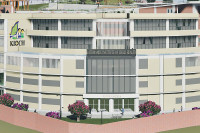Editorial
Toilet: An urban tragedy
To pee or not to pee—that is the existential dilemma we face in our stinky public lavatories.
Doctors say you should not hold your urine for long hours if you are to keep your urinary system healthy. If you do not pass around 3 litres of urine a day, urologists warn, you are at a high risk of forming kidney stones or suffering from urinary tract infection, among other complications. But imagine this: You are a street hawker or a bus driver or a porter or a day tourist in Kathmandu Valley, and you feel the urge to urinate during the day when you are out on the street. How many public toilets can you locate in your vicinity, and how many of them are functional? We reckon that asking our readers whether they can locate a functional toilet in the valley is emotional manipulation in itself.
Even those who are not out on the streets every day have a few stories each of having to return home quickly or enter a restaurant or a mall or strangers' homes during urological or faecal emergencies. Women who have to change their sanitary pads or tampons; children who have to change their diapers; senior citizens who cannot control their bladders; and persons with disabilities who cannot find ramps or tactile paving to reach the few functional toilets in the cities—each of us has a tell-tale story of the loss of dignity when it comes to excreting waste from our bodies.
And yet, we are used to going about our lives without complaining that the most fundamental of human necessities remains unmet in the metropolitan capital city that boasts of a glorious past and looks towards a prosperous future. The situation is so dire that Kathmandu Metropolitan City, a so-called modern megapolis that hosts millions of residents, boasts of just a few dozen public toilets, most of them smelly, dirty, and inaccessible to persons with disabilities. To their credit, valley mayors do not fail to announce the construction of new public toilets each year; but whether their words have turned into action is for all to see.
Urban centres outside of the valley are no different. Bureaucrats and elected representatives who have led the metropolises and municipalities in the past and the present should hang their heads in shame for their sheer inability to build and manage functional public toilets even as people continue to experience discomfort emptying their bowels and bladders, as well as face risk of infection and diseases, including cholera, diarrhoea, dysentery and typhoid due to the transmission of excreta-related pathogens.
Accessible sanitation is a citizen's fundamental human right, which should be fulfilled without an excuse. And yet, two decades through the 21st century, we are at an evolutionary stage where declaring our cities and villages open defecation free is considered a developmental success story. What is ironic, even tragic, is that the very claim of open defecation free villages and cities is often a scam, as bureaucrats, leaders and development agencies hurry to meet the Sustainable Development Goals targets on paper rather than bringing concrete changes in the way we manage human waste.




 16.16°C Kathmandu
16.16°C Kathmandu














